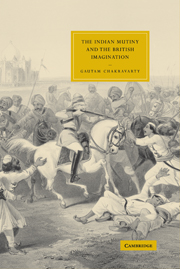Book contents
- Frontmatter
- Contents
- Acknowledgements
- Glossary
- Introduction
- 1 From chronicle to history
- 2 Reform and revision
- 3 Romances of empire, Romantic orientalism and Anglo-India: contexts, historical and literary
- 4 The ‘Mutiny’ novel and the historical archive
- 5 Counter-insurgency and heroism
- 6 Imagining resistance
- Epilogue
- Notes
- Bibliography
- Index list
- CAMBRIDGE STUDIES IN NINETEENTH-CENTURY LITERATURE AND CULTURE
5 - Counter-insurgency and heroism
Published online by Cambridge University Press: 22 September 2009
- Frontmatter
- Contents
- Acknowledgements
- Glossary
- Introduction
- 1 From chronicle to history
- 2 Reform and revision
- 3 Romances of empire, Romantic orientalism and Anglo-India: contexts, historical and literary
- 4 The ‘Mutiny’ novel and the historical archive
- 5 Counter-insurgency and heroism
- 6 Imagining resistance
- Epilogue
- Notes
- Bibliography
- Index list
- CAMBRIDGE STUDIES IN NINETEENTH-CENTURY LITERATURE AND CULTURE
Summary
[D]uring the Mutiny, it was not so much the force of numbers as the dreaded calm white face, with avenging sword in hand, that made its presence terrible whenever and wherever it appeared before the mutineers.
John Tulloch Nash, Volunteering in India (1893)It is against this self-worship I would raise my voice, however feebly, against this shameless self-praise, this painting in every gaudy color of the imperial idol in which Englishmen, each day of the week, behold the image of their own imperial faces … devouring peoples more beautiful and better than ourselves.
Wilfrid Scrawen Blunt, The Shame of the Nineteenth Century (1900)FIRST-PERSON ACCOUNTS AND THE MUTINY NOVEL
While Mutiny novels derive the broad contour of events from comprehensive histories, they rely on first-person accounts for local incident and detail. Among the first publications on the rebellion, many of these accounts belong generically to an already considerable body of British Indian travel writing. For novelists as for historians, first-person accounts were usually a veridical record of events at particular sites, detailing events and recording expatriate experience of the rebellion. The relation between the letter, diary or memoir, where the narrative is circumscribed by the horizon and knowledge of an individual, and the isochronous narration of historiography ranging over the sum of particular events, is mutually supportive. Despite Kaye's caution that eyewitnesses are not inevitably reliable, the histories by Ball and Nolan often rest their case on the evidence of personal accounts when writing about events in particular regions, cities and towns.
- Type
- Chapter
- Information
- The Indian Mutiny and the British Imagination , pp. 127 - 155Publisher: Cambridge University PressPrint publication year: 2005
- 1
- Cited by

